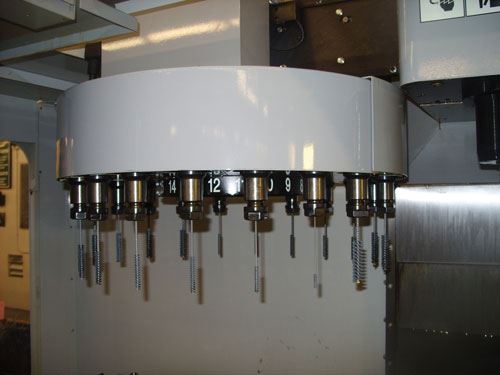Brush Hone Boosts Safety, Productivity, Finish Quality
This manufacturer recently employed the Flex-Hone ball-style honing brush from Brush Research Manufacturing to automate the finishing of die bores. In addition to providing quality and productivity improvements, the tool helped eliminate the potential for operator discomfort and injury.
By nature, manual processes can be far more costly than those that are automated with the right tools. However, for certain types of operations, the motivation to automate goes beyond potential cost and time savings. At RCBS, a manufacturer of ammunition reloading equipment, a manual finishing operation posed a significant risk to employee health and well-being. The solution, mounting a flexible, ball-style honing brush from Brush Research Manufacturing (BRM) on a milling machine, alleviated operator discomfort and reduced the risk of injury while improving part quality and productivity.
Since its founding in the 1940s, Oroville, California-based RCBS has specialized in the manufacture of ammunition reloading equipment—that is, dies and other products used to recycle spent brass casings by replacing the primer, powder and bullet. The company is part of aerospace and defense supplier ATK’s Civil Ammunition Systems Group, which manufactures small- and medium-caliber ammunition, propellant, smokeless powder and related products for commercial, military and law enforcement applications.
The process in question involved hand-finishing bores in steel ammunition reloading dies. Workers used rods wrapped in emery cloth to polish the internal surface of each die, an operation that involved extensive manual labor. The repetitive motion involved in this laborious task led to fatigue and discomfort, with many employees reporting problems with their wrists, shoulders and backs. These ergonomic issues further led to surface finish inconsistencies. "We produce hundreds of thousands of these dies every year, so the achievement of consistent, high-quality surface finishes, as well as the avoidance of worker discomfort, became a high priority that got a lot of attention," says Tim Taylor, an RCBS engineer.
The company had been seeking a solution to its ergonomic and surface finishing problems when Mr. Taylor discovered the BRM honing brush at a trade show. Known as the Flex-Hone, the tool is used widely throughout industry for deburring, plateau honing, deglazing, polishing, edge blending and chamfer operations. It consists of a shaft with protruding nylon filaments that contain hundreds of abrasive grit globules. Available in various sizes and abrasive types, the customizable hone is suitable for materials ranging from soft, nonferrous substances to carbide and ceramics. According to the manufacturer, the tool enables easy removal of even microscopic shards and fragments. It adds that the tool’s flexible construction makes it both self-centering and self-adjusting to compensate for any wear.
BRM provided recommendations and basic guidelines once RCBS decided to test the tool on a spare CNC milling machine. "I made up a fixture and started trying the process at different speeds and feeds," Mr. Taylor recalls. "It took several changes before we were able to consistently achieve our stringent surface finish requirements." Regarding those requirements, he notes that a typical steel die surface has a sub-micron roughness value when it comes off the machine. Finishing with the Flex-Hone improves that finish by a factor of eight.
Encouraged by the success of the steel die finishing solution, the company decided to try the tool on its carbide dies. For this harder material, it opted for a brush with a diamond crystal grit. The results were similar to those achieved on the steel die—a finish that "looks like a mirror when we’re done," Mr. Taylor says.
Today, RCBS employs a series of Flex-Hone brushes, all tailored to meet its die bore finishing requirements. Depending on the die, the company chooses from a selection of hone sizes and grit materials. For some applications, it uses progressively finer grits to achieve the desired result.
To automate die finishing, Mr. Taylor began by writing a very basic honing program for the CNC mill. Once he decided to go online with the process, he wrote a parametric program that requires operators to enter only four or five different parameters, such as bore length and ID. The CNC performs the necessary calculations and selects the appropriate Flex-Hone brush. Based on the operator’s input, the CNC also calculates the number of tools strokes, spindle rpm and other parameters.
"The new automated process is a real game-changer," Mr. Taylor concludes. "We realized efficiency gains of approximately 60 to 70 percent compared to doing it by hand, and there was a substantial increase in quality. It’s both better and faster, but the ergonomic improvement—the removal of the potential for operator discomfort and injury—alone would have been enough to justify the new process."
Related Content
How to Tackle Tough Angled Pocket Milling With Two Tools
Milling a deep pocket with a tight corner radius comes with unique challenges, but using both a flat bottom drill and a necked-down finishing tool can help.
Read MoreHow to Turn Machine Shop Downtime Into Process Expertise
To take advantage of a lull in business, JR Machine devised a week-long cutting tool event that elevated the shop’s capabilities with aerospace alloys.
Read More10 Tips for Titanium
Simple process considerations can increase your productivity in milling titanium alloys.
Read MoreNew Modular Tool Options for Small Spindle Milling
Tooling options have been limited for small spindle milling applications. Now modular, indexable systems are available that provide broad flexibility to get the right cutter for the job with less inventory and at lower cost.
Read MoreRead Next
The Cut Scene: The Finer Details of Large-Format Machining
Small details and features can have an outsized impact on large parts, such as Barbco’s collapsible utility drill head.
Read More3 Mistakes That Cause CNC Programs to Fail
Despite enhancements to manufacturing technology, there are still issues today that can cause programs to fail. These failures can cause lost time, scrapped parts, damaged machines and even injured operators.
Read More















.png;maxWidth=300;quality=90)














